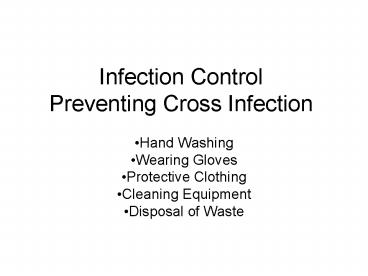Infection Control Preventing Cross Infection - PowerPoint PPT Presentation
1 / 11
Title:
Infection Control Preventing Cross Infection
Description:
Clinical Waste used wound dressings, bandages, nappies, sanitary dressings, solied gloves ... How to deal with soiled clothing, linen and nappies (information sheet) ... – PowerPoint PPT presentation
Number of Views:2300
Avg rating:3.0/5.0
Title: Infection Control Preventing Cross Infection
1
Infection ControlPreventing Cross Infection
- Hand Washing
- Wearing Gloves
- Protective Clothing
- Cleaning Equipment
- Disposal of Waste
2
Hand Washing
- The most important way to prevent cross infection
is to wash your hands. - When
- Before starting and when finishing work
- Before and after eating
- After using the toilet
- Before and after touching someone
- After handling dirty laundry or emptying waste
bins - After sneezing, coughing blowing yur nose
3
The number of germs on fingertips doubles after
using the toilet. Yet up to half of all men and a
quarter of women fail to wash their hands after
they've been to the toilet!
4
Wearing GlovesWearing gloves will also offer a
protective barrier against infection
- Infection can travel in body products, especially
blood. Cuts and grazes on hands that are not
covered by gloves may allow someone else's blood
to enter the body and cause an infection. - Gloves must be worn when
- Dealing with body products, e.g. blood urine,
mucus, sputum, vomit - Changing solied bed linen
- Clearing up spillages
- Dressing wounds and pressure sores
- Changing nappies
5
Protective Clothing
- As well as protecting your hands it might also be
necessary to protect your clothing and others
from bacteria you carry. Disposable aprons
should be worn and disposed of immediately before
going to attend another person. - Coming into contact with body fluids or waste
- Disposing of waste
- Caring for someone who is being treated for an
infection - Changing soiled linen
6
Methods of Waste Disposal
Yellow bag when the bag is full, carefully seal
and tagit indicating where the waste has come
form. The wats is burnt in an incinerator. Yello
w Sharps Box when the box is full, seal and tag
it Wash down the sluice drain, and disinfect
- Clinical Waste used wound dressings, bandages,
nappies, sanitary dressings, solied gloves - Sharps e.g. needles, glass, syringes
- Body Fluids e.g. vomit, urine, faeces, blood,
sputum
7
Swanshurst Nursery
My name is Kayleigh. I work at Swanshurst
Nursery. I get all of the lovely jobs. What
should I do in each of these situations?
8
Toddlers Room
Jinni, is 2 ½ is learning how to use the toilet.
She has accidentally wet herself. What steps
should I take to prevent cross infection when
helping her to change her clothes?
9
Pre School Room
Bobby, 4, is in the pre-school room. He fell in
the garden and cut his knee. What should
Kayleigh do to prevent cross infection when
giving Bobby First aid
Wahh. I cut myself when I was in the garden
He is always making such a fuss!!!
10
Babies Room
What is that smell?
I need my nappy changing! What steps should
Kayleigh take to prevent cross infection when
doing this.
11
AssignmentProduce a booklet for Kayleigh
explaining how to reduce the risk of cross
infection from one room in the nursery to
another.
- Include the following
- Infection Control Policy
- Correct method of disposal for hazardous and non
hazardous waste (table) - The correct method of hand washing (with
diagrams) - When to use protective aprons and gloves (mini
poster) - How to deal with soiled clothing, linen and
nappies (information sheet) - How to dispose of body fluids
- Make sure that the booklet is clear and bright
and colourful. - Good websites
- www.domestos.co.uk (hand washing, nappies, linen
etc) - www.new.wales.gov.uk (infection control guidance
for nurseries, hand washing, nappies, linen etc..)































